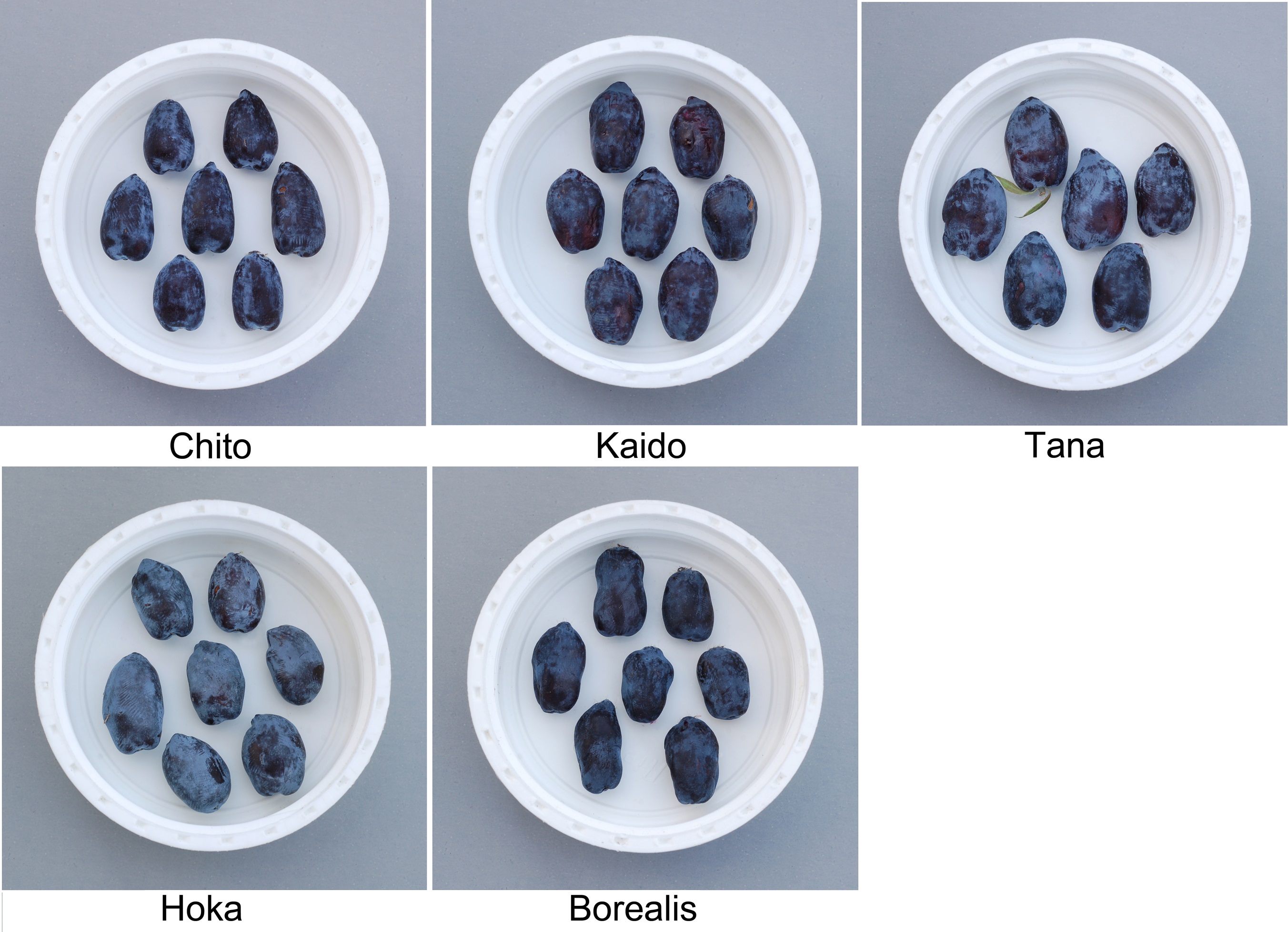Hoka
| Denomination: | 'Hoka' |
|---|---|
| Trade name: | Yezberry Sugar Pie |
| Botanical Name: | Lonicera caerulea var. emphyllocalyx |
| Applicant/Holder: |
Thompson, Maxine M. 2715 NW Frazier Creek Drive Corvallis, Oregon 97330 United States of America |
| Breeder: |
Maxine M. Thompson, Corvallis, United States of America |
| Agent in Canada: |
BioFlora Inc. 38723 Fingal Line R.R. #1 St. Thomas, Ontario N5P 3S5 Canada Tel: 519-317-7511 |
| Application Date: | 2015-07-31 |
| Provisional Protection:: | 2015-07-31 |
| Application Number: | 15-8704 |
| Grant of Rights Date: | 2020-02-20 |
| Certificate Number: | 6135 |
| Date rights revoked: | 2023-02-20 |
Variety Description
Varieties used for comparison: 'Kaido' (Yezberry Honey Bunch), 'Tana', 'Chito' and 'Borealis'
Summary: The shoot tip of 'Hoka' has a strong intensity of anthocyanin colouration while the shoot tip of 'Kaido' has a weak to medium intensity of anthocyanin colouration. The bud burst of 'Hoka' occurs mid-season whereas the bud burst of 'Borealis' occurs early in the season. The leaf blade of 'Hoka' is longer than the leaf blade of 'Kaido' and 'Tana' and larger than the leaf blade of 'Chito'. In spring, the upper side of the leaf blade of 'Hoka' is dark green while the leaf of 'Kaido' is light to medium green and the leaf of 'Tana' and 'Borealis' is light green. In summer, the upper side of the leaf blade of 'Hoka' is dark green while the leaf of 'Kaido' is medium green and the leaf of 'Tana' and 'Borealis' is light to medium green. The plants of 'Hoka' begin flowering mid-season whereas the plants of 'Borealis' begin flowering early in the season. The sepal of 'Hoka' is long while the sepal of 'Kaido' is short and the sepal of 'Tana', Chito' and 'Borealis' are medium length. The sepal of 'Hoka' is wide while the sepal of 'Kaido' and 'Borealis' are narrow and that of 'Chito' is medium width. The fruit of 'Hoka' is wider than the fruit of 'Borealis'. In cross-section, the fruit of 'Hoka' is broad elliptic while the fruit of 'Tana' and 'Chito' is narrow elliptic. In lateral view, the fruit of 'Hoka' is broad oblong while the fruit of 'Kaido' is obovate and the fruit of 'Chito' is ovate. The tufts of hairs on the apex of the fruit of 'Hoka' are present while they are mainly absent for 'Tana'.
Description:
PLANT: weak to medium vigour, upright growth habit, medium degree of branching, mid-season bud burst
ONE-YEAR-OLD SHOOT: no lenticels, absent or very sparse pubescence, red brown bark, strong development of adventitious buds
SHOOT TIP: absent or sparse pubescence, absent or weak glossiness of bark, strong intensity of anthocyanin colouration
YOUNG LEAF: sparse pubescence at base
LEAF BLADE: moderately elongated (length to width ratio 2:1), obtuse apex, absent or very sparse pubescence on upper side, absent or very sparse pubescence on lower side, dark green on upper side in spring and summer
STEM-CLASPING LEAF: large
TIME OF BEGINNING OF FLOWERING: mid-season
SEPAL: long, wide
FLOWER: medium density pubescence on corolla tube, horizontal to downwards attitude, style equal to longer than anther
TIME OF BEGINNING OF FRUIT RIPENING: mid-season
FRUIT: broad elliptic in cross-section, broad oblong in lateral view, calyx end is truncate and cordate, fruit tip present, small to medium sized eye opening, surface is smooth to intermediate, tufts of hairs at apex present
FRUIT SKIN: strong bloom, dark intensity of blue colour
Origin & Breeding History: 'Hoka' originated from an open pollinated cross made in Hokkaido, Japan in 2000 and was bred and developed by the breeder Dr. Maxine M. Thompson. The cross was made between female parent variety designated '#8' and an unknown male parent. The resulting seeds were collected and sown in Corvallis, Oregon, U.S.A. From the resulting seedlings, 'Hoka' was selected as a single plant in 2014 based on its plant growth habit, plant vigour; fruit size, appearance, taste, yield and early maturity. 'Hoka' was first propagated by hardwood stem cuttings in 2004 in Corvallis, Oregon, U.S.A.
Tests & Trials: The comparative trial for 'Hoka' was conducted in the field and examined during the summer of 2018 at BioFlora Inc. in St. Thomas, Ontario. The trial included a total of 15 plants each of the candidate variety and reference variety 'Kaido', 7 plants of the reference varieties 'Tana' and 'Borealis' and 10 plants of the reference variety 'Chito'. All plants were grown from rooted cuttings and transplanted in the field on June 9, 2016. Observations and measurements were taken from 10 plants, or parts of plants, of each variety at various times throughout the summer of 2018. All colour determinations were made using the 2007 Royal Horticultural Society (RHS) Colour Chart.
Comparison tables for 'Hoka' with reference varieties 'Kaido', 'Tana', 'Chito' and 'Borealis'
Leaf blade length (cm)
| 'Hoka' | 'Kaido' | 'Tana' | 'Chito' | 'Borealis' | |
|---|---|---|---|---|---|
| mean | 6.7 | 5.4 | 5.6 | 4.8 | 6.7 |
| std. deviation | 0.45 | 0.28 | 0.55 | 0.39 | 0.44 |
Leaf blade width (cm)
| 'Hoka' | 'Kaido' | 'Tana' | 'Chito' | 'Borealis' | |
|---|---|---|---|---|---|
| mean | 3.3 | 3.7 | 3.2 | 2.6 | 3.0 |
| std. deviation | 0.20 | 0.33 | 0.24 | 0.29 | 0.23 |
Fruit width (mm)
| 'Hoka' | 'Kaido' | 'Tana' | 'Chito' | 'Borealis' | |
|---|---|---|---|---|---|
| mean | 12.5 | 11.4 | 12.8 | 11.4 | 10.4 |
| std. deviation | 0.56 | 0.84 | 0.44 | 0.52 | 0.61 |
Click on image for larger view

Blue Honeysuckle: 'Hoka' (bottom left) with reference varieties 'Chito' (top left), 'Kaido' (top centre), 'Tana' (top right) and 'Borealis' (bottom right)
- Date modified: